The History Of Nissan Sentra

The Nissan Sentra is a compact car made by automaker Nissan Motors and is generally a rebadged export version of the Japanese Nissan Sunny. The name "Sentra" is not used in Japan, where it is currently known as Bluebird Sylphy.
Main article: Nissan SunnyIn the United States, the Nissan Sentra currently serves as Nissan's compact car and the prices range from $15,000 for a base model to $21,000 for a loaded top-of-the-line Sentra. While previous Sentras were subcompact cars, the Sentra has grown over the years, and now the Nissan Versa has replaced the Sentra in the entry-level area, although it is rated by the US EPA as a mid-size car due to its interior volume.
The Nissan Sentra was introduced for the 1982 model year as the US export name for the Nissan Sunny. Many other countries in the Americas, such as Brazil, sell their versions of the Sunny as the Sentra. In Mexico, the first three Sentras were called Tsuru (I, II and III), and the 1994 one keeps on sale after three facelifts along with the newer Sentras.
B11 (1982-1986)
This subcompact automobile was the first of the Sentras and was a direct replacement for the Datsun 210. While previous Sunnys had been rear-wheel drive, starting with the B11 they now sported front-wheel drive FF layout. The B11 also dropped the A series (OHV) engine in favor of the E15 SOHC engine out of the Datsun 310, and was the first car in the United States to carry the Nissan name solely. In 1983, all Sentras had the E16 as the only option with 4-speed manual as standard with a 3-speed automatic and, in some years, a 5-speed manual, as options. A 1.7-litre CD17 I4 diesel was also available from 1984 to 1987 (from 1983 to 1985 in the US). The diesel version was produced in small numbers and because of its rarity is becoming popular with collectors. There were several models of the B11 ranging from the Honeybee, a holdover from the 210 that achieved 35 mpg, or the Deluxe that had air conditioning, Clarion tape deck and dual side mirrors. All Sentras had 4 wheel independent suspension and front disc brakes.
In most markets, this model line was marketed as the Nissan Sunny and was available with 1.3 and 1.5 gasoline (petrol) engines. A five-door wagon (estate car) version was also marketed, too.
B12 (1985-1990)
This generation carried on the multitude of body styles that the B11 had, including station wagon, 2 and 4-door sedans, 3-door hatchback and the Sport Coupe. The B12 chassis was first produced and marketed in 1985 in most parts of the world; however, was first offered to the United States in 1986. For 1987, all Sentras but the Sport Coupe came standard with the E16(s) with 69hp (51kW) and a 5-speed manual transmission. In 1988, all Sentras had the 70hp (52kW) E16(i), which was offered for this year with throttle body injection (TBI). In many parts of the world the E series soldiered on in the B12 chassis with some getting the multi-point fuel injection E16E engine. Diesel engines were also offered in some models, but were rare and only available in certain parts of the world. From 1989 to 1990, the only engine choice was the 90hp (67kW) GA16i, a 12-valve SOHC version of the later GA16DE. The B12 carried over a radically modified 4-wheel independent suspension from the B11, with 4-wheel disc brakes an option in some parts of the world. This was the start of the model classes which were standard through the 2003 model year (not all classes were available every year) having the "E" as the low level economy car, the "XE" as the base model, the GXE as the top level for the 4 door sedan, the sporty "SE" coupe, and the "SE-R" as the top of the line performance model. The GXE (available from 1987 to 2003) had a body colored bumper, areo side mirrors with manual remote control, tachometer as well as standard 13" 175/ 70/ R13 alloy wheels along with air-conditioning, variable intermittent wipers, but no standard cassette deck nor any power windows/ locks/ mirrors. The SE also had dual mirrors, air conditioning, tachmoeter, and power door locks and windows in some markets and possibly electronic fuel injection. Back seats only came with safety lap belts and shoulder belts probably didn't exist until later models or perhaps until the next generation.
The B12 chassis would be the last chassis to offer a station wagon model, which was marketed as the "California" in some Asian markets. Even more rare are the four-wheel drive versions of the station wagon, offered as an option in 1988 and 1989 model years. These models featured an electrically-activated 4WD single-range transfer case to drive the independently-suspended rear wheels, making them selectable four-wheel-drive and not full-time four-wheel-drive vehicles. Starting in 1988 for the 1989 model year, the Nissan logo on the front grill was also switched from the right hand side to the center.
The Sport Coupe was a sportier style of the Sentra. It shared few if any of the body panels with the standard model. It was only available with the E16i or GA16i, and did not receive Nissan's CA18DE that was offered in the Sunny ZX Coupe. All Sport Coupes had dual sway bars, dual remote-adjust mirrors, and a tachometer next to the speedometer. The SE model added features like air conditioning and rear speakers.
B12s are known for reliability and great fuel economy, and are considered by enthusiasts to be good low budget project cars due to interchangeability of parts with other Nissan models.
In Kenya (East Africa), the B12 is imported and marketed as Nissan Sunny and comes with a 1.3 or a 1.5 Litre Petrol Engine. The 1.3 Litre litre version is assembled locally (1.3 SLX) and is known for greater reliability than the imported versions.
Further information: Nissan SunnyIn Canada, the four-door sedan had been in production until 1993, and was called Sentra Classic to distinguish between the late B12s and the B13s released in 1991. It replaced the Nissan Micra 3/ 5-door hatchbacks, which were discontinued that time, and were also only sold in Canada. All 1991-93 "Classic" models came with the 70hp (52kW) E16i and the choice of two transmissions, 5-speed manual or 3-speed automatic.
B13 (1991-1994)
The B13 was the first to offer Nissan's famous and then-new SR20DE engine in the sporty two-door SE-R model. Setting subcompact speed records of the time, the Sentra SE-R came with 140hp (104kW) @ 6400rpm and 132lb·ft (179N·m) of torque @ 4800rpm. It could accelerate from 0 to 60mph (100km/ h) in 7.6 seconds and the quarter-mile in 15.8 seconds. It came with 4-wheel disc brakes and had a MacPherson strut independent suspension. Further improving the handling was a viscous limited-slip differential, which was standard equipment on the SE-R. The B13 SE-R has developed a cult following over the years and is still a car of choice among tuners.
The sedan came standard with the fuel injected 110 hp 1.6 L GA16DE engine. It came in the based model, E, XE, GXE, SE, and SE-R, and Limited Edition. The GXE and Limited Edition came with power package such as power windows/ locks/ mirrors while the XE, SE, SE-R came with standard or optional sunroof and alloy wheels. Four door models came with front motorized shoulder seatbelts.
B14 (1995-1999)
The Sentra changed from an independent rear suspension to a torsion beam setup. Some variants were not equipped with a rear swaybar or rear disc brakes. Many of these vehicles equipped with the 1.6 liter dohc engine that had nissan's variable intake valve timing control system (NVTCS) and standard 5 speed manual transmission can achieve upwards of 30-40 MPG depending on conditions.
All engines in the B14 line up came with timing chains, designed to last the vehicle's lifetime.
The two-door Sentra was renamed as the 200SX and took the sporty SE-R model with it, though the sedan got all the performance parts (minus the limited-slip differential) in 1998 with the Sentra SE. The SE sedan came with the same 2.0 liter SR20DE engine as the SE-R.
The B14 sentra platform was offered several trims, Base, XE, GXE, GLE, SE and SE Limited. Base and XE come with 13" steel wheels with hupcaps, GXE prior to 1998 also included 13" wheels. The only difference between trims is the GXE and up come with rear seat trunk access, rear headrests, a grip-assist handle on the passenger side, additional fabric on doors and seats as opposed to vinyl, power windows, locks, mirrors, etc. The GLE, SE, and Special Edition include in some instances leather, rear spoiler and moonroof, and keyless entry packages. All trims except the SE and SE-R have the GA16DE 1.6L engine, 114hp (85kW). The SE and SE-R received the SR20DE 2.0L engine 140hp (104kW). The GA16DE engine is less powerful than the SR20DE engine. The 200SX SE-R came with leather wrapped steering wheel and shift knob and even Limited-Slip-Differential until 1997.
The 1998 200SX SE-R no longer offered a Limited slip differential. This generation saw the end of assembly in Smyrna, Tennessee.
Engines
- GA16DE 1,597cc 6,900rpm redline 1.6 DOHC 115hp @ 6000rpm 108tq @ 4000rpm. available in 5 speed manual/ 4 speed automatic
30/ 40mpg 5spd man 28/ 37 4spd auto 0-60mph in 8.5 seconds on 95 GXE M/ T: Car and Driver 6/ 95
- SR20DE 1.998cc 7,100rpm redline 2.0 DOHC 140hp @ 6400rpm 132tq @ 4800rpm in SE & 200SX SE-R
23/ 31mpg 5spd man 23/ 30 4spd auto 0-60mph in 8.1 seconds
Year-to-year changes
- 1995:
- 1996:
- 1997: Base, XE, GXE, Top of the line GLE
- 1998: Base, XE, GXE, (new) SE , GLE The 1998 model year saw a minor redesign of the rear light assembly, primarily the reverse indicator lights. The front grille was changed in 1998 from horizontal bars to a large plastic mesh. In 1998 the GXE was upgraded to include 14" alloy wheels , the GLE also came with 14" wheels, and the SE and Special editions along with the 200SX SE-R came with 15" alloy rims.
- 1999: XE, (Limited Edition) for GXE, SE In 1999 the front grille was redesigned yet again, this time changed from a grille to an oval hole between the head lights.
Philippine version (1998-2001)
- FE - GA13DS: 1295 cc DOHC 16 valve carburetor (power steering only, with out stereo)
- EX saloon - GA14DE: 1392 cc DOHC 16 valve EFI (all-power)
- super saloon - GA16DE: 1597 cc DOHC 16 valve EFI (all power, power antenna, ABS, SRS airbag.)
FE model (front) File:Nissan phils 1 Fe model (rear)
B15 (2000-2006)
The Sentra finally crossed over into the "compact" class for 2000. Previously, the compact class had been occupied by the Altima, which moved to the mid-size class in 2001, and its wheelbase remained unchanged from the previous generation. Also to be noted is that while earlier Sentras were very similar to their Japan-market B-series Nissan Sunny twins, the B15 Sentra diverged greatly from the B15 Sunny (a.k.a. Nissan Super Sunny). Production shifted from Smyrna, Tennessee to Aguascalientes, Mexico, and the Smyrna production line was retooled to build the Nissan Xterra.The 2000-2001 Sentra SE with the SR20DE Roller Rocker motor, which has 145hp (108kW) and 136lb·ft (184N·m) of torque, occupied the top of the line Sentra until the SE-R returned in 2002. The 1.6 L GA16DE engine was dropped in favor of the 1.8 L QG18DE (126hp) QG18DE. Numerous upgrades were made over the previous generation. The new model featured a new interior with higher quality plastics and more comfortable seats. The exterior was also substantially updated and now featured body-side moldings and clear headlights. The curb weight on the qg18de sentra is 2,513lbs.
In 2002, a new SE-R (165hp) was introduced, trading its SR20DE engine for the Altima's torquier but lower-revving QR25DE. The SE-R came in a base model with a 5-speed manual transmission or optional 4-speed automatic. The SE-R Spec V (175hp) featured a 6-speed manual transmission with a helical Torsen limited slip differential. The Spec V is capable of a 15.4 second quarter-mile, 7.0 second 0-60mph time (equal to the B13 SE-R's time) due to extra-short gearing making 60mph (100km/ h) unreachable in second gear. The SE-R (and Spec V) also featured sportier-looking headlights with black surrounding the silver reflectors as well as standard fog-lights.
2004 saw a minor face-lift for all Sentras. Gearing was changed in 2003-2006 SE-R Spec V for quicker quarter mile times of 15.2. SE-R's came only in automatic transmission from 2004-2006 and are capable of a quarter mile time of 16.0. The SE-R (Spec-V included) retained the different headlights and gained "smoked-out" brake lights. Nissan also started cost-cutting and took the front stabilizer bar out of 1.8 L models.
The Special Edition of the Sentra 1.8L was released in 2005 and it featured a rear spoiler, a black colored Spec-v interior with bucket seats, a 300watt Rocksford Fosgate sound system, a SE-R front grille, and a front tie bar for a handling improvement. It used the same QG18DE engine and was available in automatic and a very few limited 5-speed editions.
The QR25DE was not only sported in the SE-R and SE-R Spec V trims of the B15 Sentra, but also came in the 2003 Sentra 2.5LE and 2004 Sentra 2.5S. These versions did not sport any exterior resemblance to the SE-R trims, they clone the exterior and interior of the lower trims (GXE, 1.8S), to include clear head lamps, beige-colored interior cloth, lighter colored taillights (2004-2006), and softer suspension than the SE-R's. These trims were perfect for any driver that wanted the appearance of a regular Sentra with the power of a SE-R under the hood. The 2003 LE and 2004 2.5S filled the void left by the 2001 Sentra SE (SR20 powered).
The 2000-2006 2.0L and 1.8L automatics use the RE4F03B transmission. The 2.5L 2.5S, SE-R automatics use the RE4F03A transmission.
B16 (2007-present)
Nissan introduced the next generation 2007 Sentra at the 2006 North American International Auto Show in January. Now classified as a mid-size sedan by the EPA, the Sentra is larger in every dimension than the B15 model, as the Nissan Versa takes the entry-level role once filled by the Sentra. It is now based on the Renault-Nissan architecture that is also the basis for the Renault Mégane.
The chassis for the Sentra as of 2007 has been changed to the C-platform which the Sentra shares with Nissan Rogue
The Nissan Sentra SE-R Spec V is the sport compact version of the Nissan Sentra; it is the highest trim level of the Sentra. It was first produced in 2002. Its engine was the 2.5 L QR25DE unit originally created for the Nissan Altima. The engine produced 175hp (130kW) at 6000rpm and 180lb·ft (244N·m) of torque at 4000rpm. This power was enough to propel the car to 60mph (100km/ h) from standstill in 7.5 seconds.
The car came standard with a 6-speed manual transmission, a helical Torsen limited slip differential, and 17-inch wheels with performance tires. Perhaps as impressive as the car's quickness was its handling, which was the result of aggressive factory-tuning of the car's suspension and the addition of low-profile tires, which fortunately did not severely harshen the car's smoothness. It also has 280mm×22mm vented discs for the front brakes and 232mm×7mm solid discs in the rear, or optional Brembo brakes. Along with a standard race-inspired sporty interior, other optional features at the time included a 300-watt nine-speaker audio system (with an 8-inch subwoofer in the trunk) and a power sunroof.
Initially, for 2002 and 2003, the SE-R Spec V (along with the SE-R) was given an aggressive front fascia (borrowed from the Skyline GT-R) with side still extensions and rear trunk-mounted spoiler. For the 2004 and 2005 model years, cosmetic changes were made to make the Spec V look like regular Sentras from the front, although it still retained its side-skirt extensions, rear spoiler, and Six-Spoked 17-inch wheels (albeit different ones from 2002 and 2003 models). The 2004 model year also featured a new style of taillight which is somewhat inspired by the Skyline GT-R's quadruple taillights. Other cosmetics added in 2004 that were akin to the Skyline GT-R are the six-spoked wheels, the "SE-R" badged shifter handle from the previous models remained, and the availability of Sapphire Blue.
Service Issues
While the SE-R Spec V was considered one of the best valued sports sedans, there are service issues some SE-R owners have experiencesd. One common problem[citation needed] involves the Intake Manifold "Butterfly" screws being loosened over time and eventually being ingested into the Intake. This would obviously cause a great deal of damage, and there have been plenty[citation needed] of SE-Rs with new engines because of this. The solution adopted by many owners was to use Loctite to lock the butterfly screws in place. Nissan later recalled 2004 and early 2005 models to have a similar procedure performed on the intake manifold. The butterfly screws were replaced with a new design and had loctite applied during installation, a mesh screen was installed as well in case a screw still became loose. Previous years including some 2004 models were refused the recall by Nissan.[citation needed]
In the exhaust system unburnt fuel that entered the Pre-Cat could potentially ignite; over time bits of the Pre-Catalytic Converter would break off and be sucked back into the engine. The QR25DE has no EGR valve, by design the exhaust valves are left open for a short period of time during the intake stroke to reburn fuel in the exhaust system, this is when particles from the Pre-Cat have an opportunity to re-enter the engine causing damage. The solution to this by Nissan was to have dealers replace the Pre-Cat with a new Pre-Cat of the same design and making ECU modifications. Many owners[who?] have experienced multiple engine failures due to this, others[who?] have accused Nissan of simply putting a bandaid on the vehicles until most of their warranties have run out. Nissan has basically refused to find a solution to this problem. Many owners[who?] have again been forced to come up with their own solution which was replacing the OEM exhaust manifold with an aftermarket "pre-cat-less" manifold. This is not illegal[citation needed] in most states, except for California[citation needed] where it may not pass a visual inspection. This modification is legal[citation needed] due to the fact that only the pre-cat has been removed and the catalytic converter is still intact. This solved the problem of ingesting pieces of Pre-Cats that come apart over time by removing the Pre-cat entirely. Every year of the SE-R from 2002-2005 has been found to be capable of the same failure[citation needed]. No 2006 models have been reported[who?] as of this posting. However, 2006 models have had their own problems when Nissan switched the design of the oil rings to save costs. These engines had to be recalled due to multiple engine failures and fires. These failures have also affected all 2.5L Altimas as well.
2007-present
Nissan introduced a new version of the SE-R to the North American market for the 2007 model year. The SE-R is available in two versions: SE-R base and SE-R Spec V. Both get four-wheel disc brakes in place of the standard Sentra's disc/ drum setup, unique interior and exterior trim and 17" alloy wheels. Both are powered by the 2.5 liter QR25DE engine.
The base model is rated at 177hp (132kW) @ 6000rpm and 172lb·ft (233N·m) @ 2800rpm and comes exclusively with Nissan's X-CVT continuously variable transmission and steering wheel-mounted paddle shifters. The SE-R base model starts at $19,400 (MSRP).
The SE-R Spec V is rated at 200hp (150kW) @ 6600rpm and 180lb·ft (244N·m) @ 5200rpm and comes with a 6-speed manual and optional limited-slip differential. It is capable of 0-60mph times of 6.4 seconds and a 1/ 4mile time of 14.9 seconds. The Spec V also gets red front seat belts, bigger front brakes and a stiffer suspension. The SE-R Spec V model starts at $19,900 (MSRP).
See also: Nissan Pulsarand Nissan SunnyIn countries such as New Zealand, vehicles from both the Nissan Sunny and Nissan Pulsar ranges were marketed as a single model range (With the exception of the Pulsar, which included an EXA model identical to the North American Pulsar), the "Nissan Sentra"—which differed (apart from the station wagon) from the models sold under the same name in the United States.
The Sentra name was adopted in several other countries, such as New Zealand, where it was used for the Nissan Pulsar range from 1986 (though, interestingly, the station wagon version was actually a rebadged Nissan Sunny California). The Sentra name continued to be used in New Zealand for the Pulsar until 1998, just as Almera was used in Europe. After 2002, the Japanese Pulsar name was adopted.
Unlike the North American version, a hatchback was offered; engines offered were 1.4 L, 1.6 L and 2.0 L petrol engines; a diesel was available in Europe. Some were sold in the Republic of Ireland.
In Taiwan, Yulon has built its licensed version of the Sunny as the Sentra since 1990. The current Taiwan-market Sentra reflects the styling of the Japanese-market Bluebird Sylphy (also the Almera/ Pulsar sedan but with a luxury emphasis). This N16 model is called Sentra M1.
In Indonesia, the first and second generations Sentra were the Sunny-based B12 and B13 models respectively. The 1988-1990 B12 was offered as SGX Sedan and SR Coupe. The B13 was nick-named Sentra Genesis, only sold as sedan from 1991 to 1996.
After skipping 6 years, Nissan re-introduced the Sentra in Indonesia in 2002. The Sentra is now based on the N16 Pulsar or Nissan Bluebird Sylphy. It's powered by 1.8 liter QG18 engine matched to 4 speed automatic transmission. The Sentra is only offered in luxury Super Saloon trim level, loaded with standard ABS and leather interior. However, it sold only in small numbers until 2004.
Today, the Philippines also uses the Sentra name for its version of the Pulsar. The N16 model is known as Sentra Exalta (only available from 2001-2003). The early model is similar to JDM Bluebird Sylphy, the facelift model is the same as Sunny Neo in Thailand. The current Sentra has 3 lines and 2 engine choices, which include a 1.3 and a 1.6. The 1.3 Sentra is considered one of the cheapest vehicles in the Country
In Mexico, parts of Central America and South America (Non Mercosur (Brazil and Argentina) the B13 Nissan Sentra is still sold. Called the Nissan Tsuru (Mexico), (Nissan V16 in Chile and Sentra Clásico in Peru and Dominican Republic), (Sentra B13 in Bolivia), and made in Mexico, it is the same basic car only with minor cosmetic changes and mechanical downgrades to make it cheaper, such as non-power steering, downgraded interior trim, a downgraded braking system, and a mechanical clutch instead of a hydraulic one. More recent models have received a Renault-built hydraulic clutch. Its affordable price made it popular among local taxi drivers.
It is expected to last in production until summer 2009; this model is reaching the end of its life after a 17-year run.
From Wikipedia, the free encyclopedia
More About Nissan Sentra
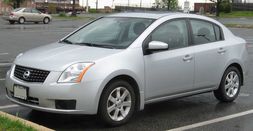
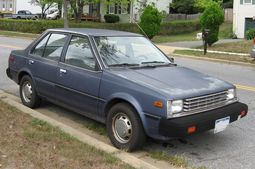
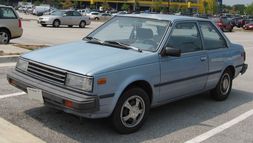


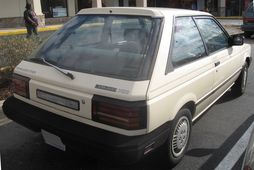
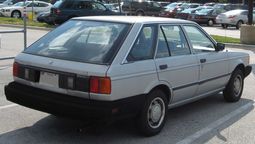
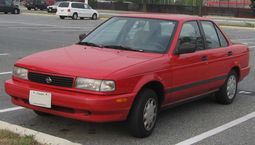

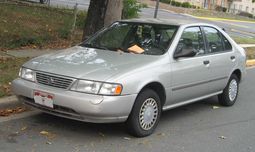
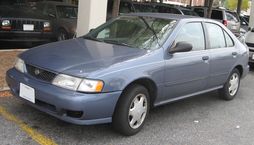
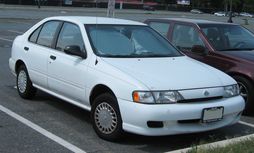
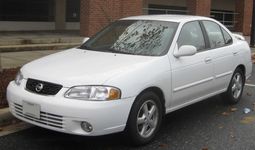
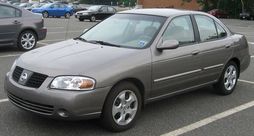
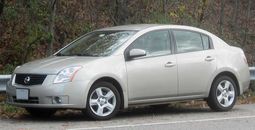
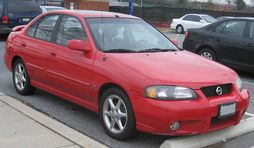

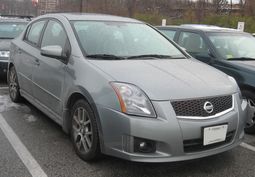
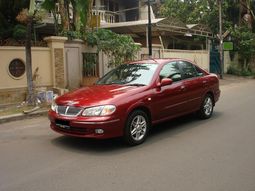

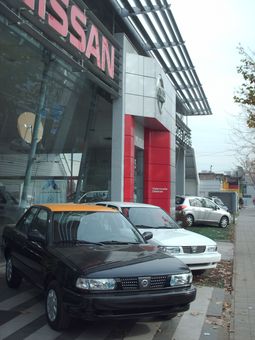
|